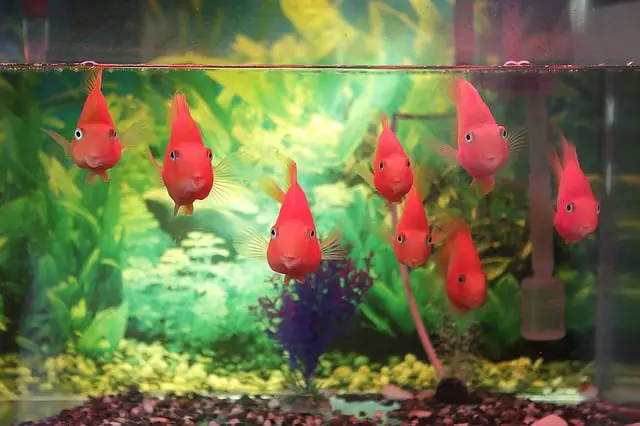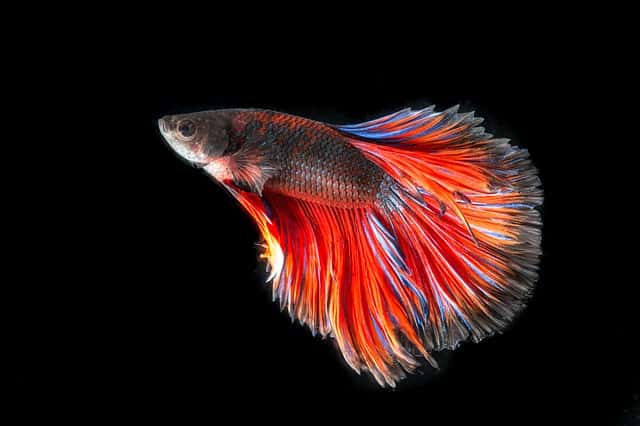Most of the discussion I hear in the aquarium hobby when it comes to aquarium size is how big should a fish tank be? The flip side to this debate is the title of this article – what happens if a fish tank is too small?
If a fish tank is too small, your fish can become aggressive towards each other. Water parameters can get out of control quickly, potentially causing illness and/or death. Not having enough space to swim for some fish species can also cause stress.
As you can see, having a fish tank that’s too small just isn’t good for your pets. It’s not okay for most fish to be kept in such close quarters and can even end up killing them. There are some circumstances when a small tank is okay, such in the case of nano tanks. However, these aquariums tend to be minimally stocked with relatively small fish.
In this article, I’ll go over how a tank that’s too small can negatively affect your fish and when it’s okay to have a small tank. If you are ready to learn more about this topic then, let’s get to it!
What is Considered a Small Fish Tank?
Before we talk about what happens when you put fish in a tank that’s too small for them, let’s quickly go over what a small fish tank is.
This might be obvious, but it needs to be said. A fish tank that’s too small is one that doesn’t allow enough room for its inhabitants to swim about and explore freely.
Some species are schooling fish and some aren’t. It’s best to know which fish you want to keep in your tank so you can plan ahead.
There’s the old ‘rule of thumb’ in this hobby that states “an inch of fish per gallon of water”. Now as good as this is for beginners to use as a guideline, it doesn’t always work. For example, if you want to keep neon tetras, an inch of a tetra is much different than an inch of an Oscar!
Neon tetras are very small fish that rarely get larger than 1.5” in captivity and have tiny bodies where an oscar is a very large-bodied fish and can grow up to 12” or more in captivity.
Then you must consider, if you’re purchasing schooling fish such as cories, how many should be together and how big they will end up getting. If you get 5 or 6 cory catfish which can grow up to 2” each and follow the inch of fish per gallon rule, a 10-gallon tank is probably too small. A 20-gallon would be a better fit for a school of cory catfish.
There are so many scenarios with fish and tank sizes that we could go on and on about. I hope you get the idea from what I’ve told you so far. I have put together a list below of different fish and what size tank they are best suited for.
What Happens if You Put Fish in a Small Tank?
Putting fish in a tank that is too small will most likely end up badly. On the other hand, if you put a couple of guppies in a 5-gallon tank, they would probably do just fine. Well, fine until they have fry and then overcrowd the tank – eventually making the tank too small for the two original fish and their fry.
Ultimately, a small tank is not ideal for some fish. Their quality of life is poor which leads to stress and sometimes disease and possibly the fish dying.
Aggression can also be an issue in a small tank. When fish are placed in close quarters and have nowhere to hide or retreat to, they can start to get nippy and pick at weaker fish.
I have seen this happen with putting fish in too small of a tank and I have seen this happen when a school of fish has some fish die off, leaving less than the optimal number of fish for a school. You must remember you are taking care of wild animals and sometimes they will act like it.
Water parameters will always be one of my biggest concerns when dealing with smaller tanks.
If you fully (or over) stock a small aquarium, especially by means of putting the wrong fish in the tank, you run the likely risk of water parameters such as ammonia and nitrites spiking.
These toxic byproducts of organic materials breaking down in a fish tank are deadly to fish if left undealt with. Smaller tanks can have ammonia and nitrite spikes quite easily because there isn’t very much water. If you add fish that are too big for the tank, you increase the chances of this happening.
Fish require food and excess food settling in the substrate, along with the fish poop that ends up accumulating, can be dangerous for the fish. If you add live plants that are decomposing without being cleaned out of the tank, it gets even worse.
If you had placed the fish in a tank suitable for those fish, there would be more water and possibly larger filtration to help deal with the toxic results of things such as too much nitrite and ammonia.
Is it Cruel to Keep Fish in a Small Tank?
I have a good article on this topic and whether keeping fish in tanks is ethical. Check it out here.
I want to quickly touch on this subject here to get you thinking right, if you are in fact wanting to use a tank that is too small.
Is it okay to keep fish in a small tank? Or is it okay to confine a living creature in a space that is uncomfortable to live in and can put them in danger?
It’s probably not okay, but that’s for you to decide. Do the right thing.

What Fish Can Live in a Small Tank?
So, now we understand we need to do our best to get any fish we purchase into a fish tank that will provide them enough space to live a long and healthy life.
But what fish can live in a small tank? Most people will ask what a small tank is. In my mind, anything less than 30-gallons is probably a small aquarium.
There are a ton of fish you can house in a 30-gallon or less fish tank.
In the next section below, I am giving you a big list of fish and what tank size best suits them.
You must also consider if you are adding different types of fish to create a community tank and account for all fish when deciding what size of aquarium they can be kept in.
Aquarium Fish and the Size Tank They Should be Kept in
Okay, so this might be the information you really came here for. In no particular order, I’m going to list the fish name, whether they are schooling fish or not, how many should be kept in a school, and the size of tank that particular fish can be kept in safely.
Always remember to calculate all the different fish you want in one specific tank. Don’t just say to yourself, ‘I see 5 or 6 neon tetras can be kept in a 10-gallon’, then go and buy 5 or 6 cory catfish as well for the same tank. That’s too many fish and you’re bound to have trouble keeping the fish alive.
Let’s get to it.
Schooling? How Many? Min Tank Size
Freshwater Fish
Mollies Yes 4+ 30-gallon
Platies Yes 4+ 20-gallon
Neon Tetras Yes 5+ 10-gallon
Cory Catfish Yes 6+ 20-gallon
Dwarf cory catfish Yes 5+ 10-gallon
Guppies Yes 5+ 20-gallon
Cichlids Yes/No 5+ 50-gallon
Glofish Yes 5+ 10-gallon
Goldfish Yes/No 1 30-gallon
Bala shark Yes 5+ 40-gallon
Kuhli loach No 1 20-gallon
Clown loach Yes 5+ 50-gallon
Swordtails No 1 15-gallon
Betta fish No 1 10-gallon
Plecostomus Yes 5+ 30-gallon
Angelfish Yes/No 2 50-gallon
Rainbow fish Yes 5+ 50-gallon
Tiger Barbs Yes 6+ 20-gallon
Oscars No 1+ 50-gallon
Gouramis Yes 8+ 30-gallon
Discus Yes/No 1+ 50-gallon
Killifish Yes 5+ 30-gallon
Hatchets Yes 6+ 20-gallon
Rasbora’s Yes 5+ 20-gallon
Pea Puffers Yes 5+ 10-gallon
Ghost catfish Yes 5+ 15-gallon
Black ghost knife fish No 1+ 100-gallon
Elephant nose fish yes 3+ 75-gallon
Saltwater Fish
Clownfish (percula) No/Yes 1+ 30-gallon
Mandarin gobies No 1+ 30-gallon
Chromis Yes/No 4+ 30-gallon
Cowfish No 1+ 100-gallon
Angelfish No 1+ 50-gallon
Triggerfish Yes/No 1+ 75-gallon
Pajama Cardinals Yes 5+ 50-gallon
Damsels Yes 5+ 50-gallon
Lionfish No 1 100-gallon
Wrasse Yes 4+ 30-gallon
Blennies Yes 4+ 30-gallon
Tangs Yes 3+ 75-gallon
Firefish Yes 3+ 50-gallon
Flame Hawkfish Yes/No 1+ 30-gallon
These are all of the more common freshwater and saltwater fish I could think of that you would most likely find in your local fish store.
Of course, there are always exceptions, for instance an oscar fish might need a large tank as it gets older but having one in a 20-gallon while it’s still very young, probably isn’t a problem.
This list is a good guideline for you if you are new and inexperienced in the aquarium hobby.
Just use your brain when deciding on what size tank and I’m sure you’ll do fine.
Conclusion
To wrap up this article, let’s quickly go over the points you should take away.
Small tanks can have issues with aggressive fish and water parameters getting out of control quickly.
Every scenario will be different because every fish is different. There are younger smaller fish that will stay small and there are smaller younger fish that will grow quite large.
Knowing how big your fish will grow will help you pick the right size tank for them, avoiding any issues with aggression or water parameter problems.
Thanks for reading and good luck!
Related Posts
What Saltwater Fish Can Live in a 5-Gallon Tank
Super Cool Fish for a 10 Gallon Tank
How to Stop Fish from Jumping out of a Tank?
What are Common Fish Tank Problems?






